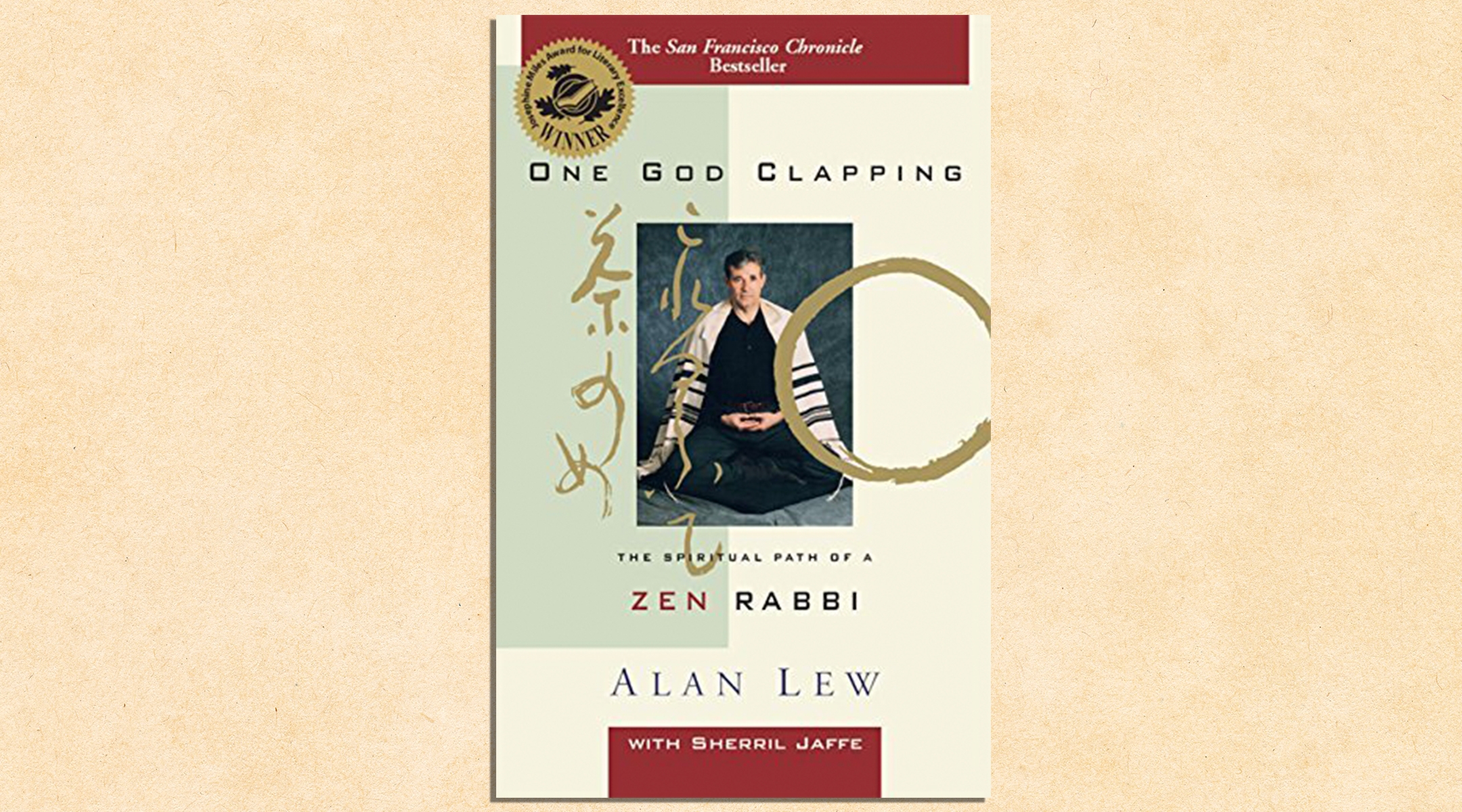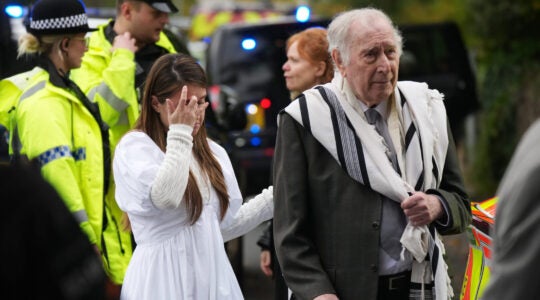(JTA) — Every few years I put out a call asking what people will be reading in preparation for the High Holidays, and usually one book tops the list: “This Is Real and You Are Completely Unprepared: The Days of Awe as a Journey of Transformation,” by the late Rabbi Alan Lew.
Published 20 years ago this month, “This Is Real” is an attempt by Lew, a Conservative rabbi trained in Buddhist practice, to get perhaps jaded readers to see the period that includes Rosh Hashanah, Yom Kippur and Sukkot as a time for deep spiritual introspection — or, as he writes, a time to “move from self-hatred to self-forgiveness, from anger to healing, from hard-heartedness to brokenheartedness.”
If that sounds like the gospel of “self-care,” you’re not far off. Lew, who died in 2009 at age 65, came of age during the self-actualization movement, a serious attempt by psychologists to get people to live up to values that transcend their desire for wealth and status. By the time cosmetics companies, crystal sellers and lifestyle influencers took hold of the concept, it was derided as selfishness disguised as a spiritual journey.
But Lew’s book grounds concepts of “self-discovery, spiritual discipline, self-forgiveness and spiritual evolution” in normative Judaism. “This Is Real” never strays far from a traditional Judaism that saw the period of prayer, reflection and repentance surrounding the holidays as a time for a moral wake-up call.
That hybrid of the traditional and the much-maligned “New Age” continues to appeal to readers. Jewish educator Joshua Ladon, writing in the 2020 anthology “The New Jewish Canon,” calls the book “the handbook for American Jewish High Holiday survival,” comparing its influence to Rabbi Harold Kushner’s mega-bestseller “When Bad Things Happen to Good People.” Synagogues host book groups to discuss the book in the run-up to the holidays; the book’s publisher, Little, Brown and Company, issued a paperback version only in 2018, suggesting its hardcover sales had remained strong for 15 years.
Ilana Sandberg, a rabbinical student at JTS, recommended Lew’s book last month in a video for the seminary.
She first read the book in the fall of 2020 as she was preparing to lead High Holiday services at Brandeis Hillel for the first time as the rabbinic intern, and considers the late author her “spiritual hevruta,” or study partner, in the lead-up to the holidays. The book, Sandberg says, is about “accepting this idea that we are ever-changing beings and there really is a possibility for change, for renewal as we go through the cycle of the year.”
Lew was spiritual leader at San Francisco’s Congregation Beth Sholom from 1991 to 2005. Raised in Brooklyn and New York’s Westchester County, he was underwhelmed by the suburban Judaism of the 1950s and ’60s and, like many Jewish seekers of his era, turned to Zen Buddhism — at one point considering becoming a lay priest.
“It was in a Buddhist monastery, meditating, that I realized who I really am. I am a Jew,” he wrote in “One God Clapping: The Spiritual Path of a Zen Rabbi,” a memoir he co-wrote in 2001 with his wife, Sherril Jaffe. “A Jew can use the practice of meditation to illuminate his or her Jewish soul.”

Rabbi Alan Lew appears on the cover of “One God Clapping: The Spiritual Path of a Zen Rabbi,” a memoir he co-wrote in 2001 with his wife, Sherril Jaffe.
A poet and sometime bus driver, Lew was 38 when he enrolled at the Jewish Theological Seminary, the training ground for Conservative rabbis. In 2000, he founded Makor Or, a Jewish meditation center housed at his synagogue.
In “This Is Real,” he writes about the meditative aspects of High Holiday prayer. “When we sit in meditation with other people, breathing the same air, hearing the same sounds, thinking thoughts in the same rhythms and patterns, we experience our connection to each other in a very immediate way,” he writes.
But Lew’s version of the High Holidays is hardly passive or even gentle: Preparing for the holidays, as he suggests in the title, is hard and daunting work. The dreamlike opening sequence describes the “journey” of the High Holiday period as “fraught with meaning and dread.”
Ladon wrote that Lew’s book represents “the possibility of American Judaism, full of vitality and transcending boundaries.” Perhaps because of, or even in spite of this, it was mostly non-Orthodox Jews who replied to my recent social media post asking about their attachment to “This Is Real.”
“I’m really moved by the way that Lew takes the traditional images of the Holidays — the wake-up call of the shofar, the books of life, death and the undecided, the opening of the gates — and retells them in a way that they speak directly to my personal existential discomfort,” wrote Jonah Mendelsohn, an actor and writer who has been reading the book with fellow members of SAJ, a Reconstructionist synagogue in Manhattan. “The book has me facing my own insecurity and self-judgment in a way that isn’t always comfortable, but pushes me to change.”
Karen Paul, a fundraising consultant and former executive director of the Washington, D.C.-based Tikkun Olam Women’s Foundation, said a friend gave her a copy of the book the year her husband died from glioblastoma.
“Lew’s comforting and relatable stories were precisely the roadmap I needed to begin to reshape my future,” she told me. “My favorite parable in the book is the day that the rabbi had to be on one side of the park for a [funeral] and the other side of the park for a birth. This is the dialectic of life, which, if we listen for it, applies to all that we do.”
Rabbi Rachel Barenblatt of the Reform Congregation Beth Israel of the Berkshires in North Adams, Massachusetts, recommends the book for “folks who might not self-identify as seekers, but who are interested in approaching the holidays in a deeper or more informed way.”
“When I first read it, it changed how I experience this two-month window of time, and I love opening that up for those whom I serve,” she wrote me. “How can we harness this season to fuel our inner work so that we can emerge ready to grow and become and try again?”
But she, like others, notes that “This Is Real” isn’t without its flaws. She suggests that Lew “had some blind spots, notably around gender.” (Last year, Jewish blogger Shari Salzhauer Berkowitz criticized his “heterosexual, male” handling of the sexual dynamics in Ki Tetze, the Torah portion that includes instructions for soldiers taking women captives as “wives.”)
The book also has admiring references to Rudy Giuliani — the New York City mayor turned RICO defendant — and Rabbi Shlomo Carlebach — the songwriter who faced posthumous allegations of sexual misconduct — that read differently now than they did 20 years ago.
Barenblatt suggests pairing his book with a “contemporary and feminist text” such as Rabbi Danya Ruttenberg’s recent book “On Repentance and Repair.”
Lew’s style — he glides between poetry and memoir, allegory and darshanut, or Torah commentary — isn’t for everyone. Many prefer Nobel laureate S.Y. Agnon’s anthology “Days of Awe,” first published in English in 1948, a collection of mostly primary texts related to the High Holidays. Philip Goodman’s various anthologies for the Jewish Publication Society take a similar approach. The 1999 essay collection, “Beginning Anew: A Woman’s Companion to the High Holy Days” by Gail Twersky Reimer and Judith A. Kates is a corrective to books that ignore the central place of women in the liturgy.
Many of these books seem intended for readers who are looking for inspiration in synagogue when their attention begins to flag. Lew invites you to read his book as a coherent narrative of a nearly three-month process from destruction (Tisha B’Av) to joy (Sukkot).
But for some readers, it is also a book to be dipped into and sipped from.
“I have never finished this book,” Pittsburgh Rabbi Mark Asher Goodman admitted last month in a column recommending books for the High Holidays. “I read four or five pages. I stop and ponder over the meaning of existence and God and human growth and obligation and fallibility. Lew is poetic and instructive and guru-esque but also deeply personal; you feel you know him. The book’s title is perfect, and yet the book really will prepare you for the High Holidays, even if you, like me, never actually finish reading it. One might argue that this book, if properly read, is never finished.”
JTA has documented Jewish history in real-time for over a century. Keep our journalism strong by joining us in supporting independent, award-winning reporting.







